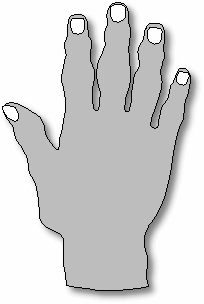 |

|

| What is it? |
-
Osteoarthritis is a deterioration of the moving parts of the joints. In
the hand, osteoarthritis most often affects the small joints of the fingers
and the joint at the base of the thumb - the basal
joint. This is sometimes referred to a degenerative arthritis or degenerative
joint disease. Osteoarthritis is primarily treated by medical doctors,
and may require treatment by an arthritis specialist. Medical resources
on arthritic conditions are available through the American
College of Rheumatology.
|
| What caused it? |
-
The exact reason for developing osteoarthritis is not known.
-
It is thought to be due to deterioration of the smooth layer of cartilage
which covers the ends of the bones. The small joints of the fingers are
prone to breakdown of this layer, which seems to self-destruct in some
people early in life.
-
It tends to run in families, and is probably a genetic condition in many
people.
-
Degenerative joint disease can also occur after injury, but the typical
pattern of osteoarthritis is that the small joints of the fingers are affected,
but the other joints of the hand are not.
-
Osteoarthritis is different from other forms of arthritis, such as rheumatoid
arthritis, gouty arthritis, psoriatic arthritis and others.
|
| What can you do to help? |
-
A heating pad or warm water soaks for five minutes in the morning to limber
up.
-
Ice for five to fifteen minutes at a time on the area which is most swollen
and tender.
-
"Over the counter" non-steroidal anti inflammatory medication (NSAID),
such as aspirin, ibuprofen, naprosyn, or ketoprofen. Check with your pharmacist
regarding possible side effects and drug interactions.
-
There is some scientific evidence to suggest that chondroitin / glucosamine
preparations may be helpful in osteoarthritis. These preparations are available
without a prescription, but may affect your glucose and cholesterol tests,
so it's not a bad idea to check with your doctor. Other supplements and
treatments are of unknown value and unknown risk.
-
Wait and watch.
|
| What can a therapist do to help? |
-
Provide a variety of hand splints to support the thumb and the wrist.
-
Help identify aggravating activities and suggest alternative postures.
-
Massage, heat, ice and other treatments aimed at making the area more comfortable.
-
A hand therapist can provide advice on living with arthritis, and give
helpful information on how to live one's life without aggravating or accelerating
the damage caused by arthritis. This is often referred to as a "joint
protection program".
-
Therapists can also provide some special tools to assist people whose hands
have been affected by arthritis perform routine daily activities. These
are called "adaptive devices".
-
If surgery is required, therapy after surgery is very important. Custom
splints may need to be made and maintained by a skilled hand therapist.
|
| What can a doctor do to help? |
-
Confirm that this actually is the problem.
-
Prescribe stronger NSAID medication or cortisone type medication.
-
Prescribe hand therapy and/or a custom splint.
-
Give a cortisone shot into sore joints. This can be very helpful in controlling
pain and swelling.
-
Perform surgery to reconstruct or fuse the involved joints. There are two
types of surgery commonly performed for joints affected by arthritis, fusion
and arthroplasty. Surgery is a consideration when all else has failed.
|
| How successful is treatment? |
-
Many people with mild symptoms will improve with a limited period of anti-inflammatory
medication and avoiding painful activities.
-
A cortisone shot into the sore area helps most people - at least temporarily.
When temporary, relief usually lasts about two months.
|
| What happens if you have no treatment? |
-
It depends on how much it is bothering you - it really is a quality of
life issue. This is not a problem which can spread to other parts of your
body. Many people have pain which subsides after a few years, when the
arthritis and irritation in this joint "burns out".
-
The main reason to do surgery is to relieve pain and, when possible, prevent
the progressive weakness and deformity which may occur. Some people will
have a mild problem which flares up from time to time, and treat it themselves
or ignore it, others will have a severe problem which prevents them from
doing many things with their hand, and feel that they have no choice but
to have surgery.
|
|
 |
American
Society
for
Surgery
of the
Hand
assh.org
The Best
Resource
For Your
Hands,
Period.
|